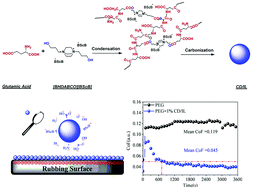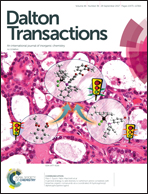Facile synthesis of photoluminescent inorganic–organic hybrid carbon dots codoped with B and N: towards an efficient lubrication additive†
Abstract
A novel environmentally friendly bis-functional dicationic ionic liquid containing chelated orthoborate was synthesized and polycondensed with glutamic acid in order to synthesize inorganic–organic carbon dots (CD/IL) consisting of an ionic liquid moiety inserted in the carbon skeleton. The obtained CD/IL was found to be a new kind of nitrogen/boron-codoped nanomaterial, one with a mean particle diameter of 2.66 nm. CD/IL was verified to be a high-performance lubricant additive: in particular, the anti-wear and friction-reducing properties of poly(ethylene glycol) (PEG) were improved by 89.34% and 62.18%, respectively, when 1% CD/IL was added. Lubricants consisting of a mixture of CD/IL and PEG showed intense blue photo-fluorescence, and the corresponding photoluminescence (PL) intensity decreased considerably after carrying out a tribo-test. Moreover, CD/IL became transferred onto a rubbing steel interface during the tribo-test according to EDX and Raman analyses of a worn surface. CD/IL showed poor crystallinity, and interestingly, an intense G (∼1600 cm−1) signature was detected on the steel surface after a high-load and long-duration tribo-test, which indicated that ordered carbon materials were generated on the interface, inhibiting the undesirable wear.



 Please wait while we load your content...
Please wait while we load your content...